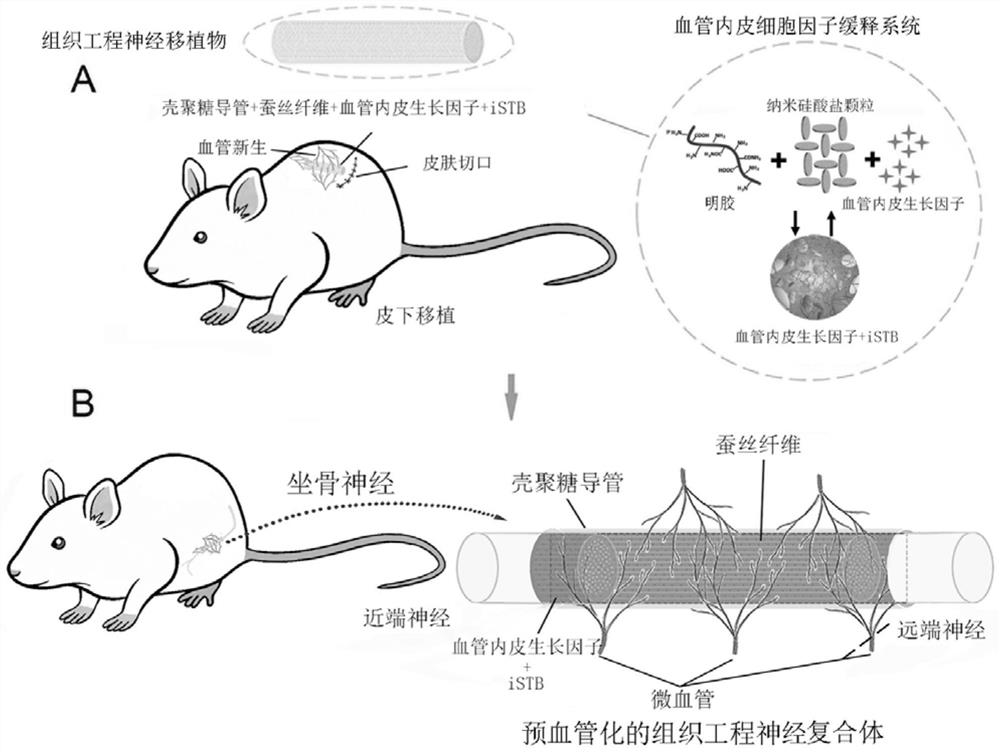Tissue engineering nerve complex as well as preparation method and application thereof
A tissue engineering and complex technology, applied in the field of biomedical materials, can solve problems such as unfavorable standardized operation, leakage, abnormal shape of blood vessels, etc., to improve the local microenvironment of injury, reduce immune rejection, and improve local microcirculation. Effect
- Summary
- Abstract
- Description
- Claims
- Application Information
AI Technical Summary
Problems solved by technology
Method used
Image
Examples
Embodiment 1
[0047] 1. Construction of VEGF-iSTB sustained release system
[0048] Prepare 18% w / v gelatin solution (type A, G1890, Sigma, CA, USA) and 10% w / v SNPs solution (Laponite XLG, BYK Additives Ltd, TX, USA) with Milli-Q water respectively; Composite hydrogel iSTB of proportional gelatin and SNPs.
[0049] Biocompatibility, angiogenic effect, and cell migration experiments were carried out on iSTB prepared by different ratios of gelatin and SNPs, human umbilical vein endothelial cells (HUVECs) and human skin fibroblasts (HDF) in vitro, and the construction of VEGF was determined according to the experimental results. - Optimal ratio of gelatin and SNPs in iSTB sustained release system.
[0050] In order to test the angiogenic effect of VEGF-iSTB slow-release system on vascular endothelial cells, human umbilical vein endothelial cells (HUVECs) were cultured in well plates coated with different VEGF-iSTB slow-release hydrogels, and photographed at different time points Recorded, a...
Embodiment 2
[0059] Construction of prevascularized tissue-engineered neural complexes
[0060] VEGF-iSTB tissue-engineered nerve grafts consisting of chitosan nerve guides, built-in silk fibroin scaffolds, and iSTB containing different concentrations of VEGF were pre-implanted subcutaneously on the back of rats, and the gross and histological observations were made at different time points after transplantation Inflammatory immune response and prevascularization of tissue engineered neural complexes.
[0061] VEGF-iSTB was injected into the nerve conduit through a syringe to completely fill the cavity space. Tissue-engineered nerve grafts composed of iSTB containing 1 μg / mL VEGF were pre-implanted subcutaneously on the back of rats, and samples were taken 4 days, 7 days, and 14 days after transplantation for direct observation under a stereomicroscope and immunohistochemical staining (CD34) to observe the tissue Prevascularization of engineered neural complexes.
[0062] Such as Figur...
Embodiment 3
[0065] 1. Evaluation of the effect of prevascularized tissue engineered nerve complex pontogenesis on angiogenesis
[0066]Establish rat sciatic nerve defect model, after intraperitoneal injection of anesthesia, routine skin preparation, incision of the skin and subcutaneous tissue with traces of gluteus gluteus superficialis and biceps femoris, blunt dissection of the oblongus muscle space to expose sciatic nerve, experimental group, autologous group and bracket The rats in group 1 were excised about 10mm of sciatic nerve at the middle part of the femur. The 10 mm defect of rat sciatic nerve was repaired by bridging the prevascularized tissue engineered nerve complex, and the non-prevascularized tissue engineered nerve graft repaired the rat sciatic nerve defect was set up as the negative control group. The tissue-engineered nerve complex and the epineurium were sutured with microscopic sutures respectively, the positions of the nerves of each group in the intermuscular space...
PUM
 Login to View More
Login to View More Abstract
Description
Claims
Application Information
 Login to View More
Login to View More - R&D
- Intellectual Property
- Life Sciences
- Materials
- Tech Scout
- Unparalleled Data Quality
- Higher Quality Content
- 60% Fewer Hallucinations
Browse by: Latest US Patents, China's latest patents, Technical Efficacy Thesaurus, Application Domain, Technology Topic, Popular Technical Reports.
© 2025 PatSnap. All rights reserved.Legal|Privacy policy|Modern Slavery Act Transparency Statement|Sitemap|About US| Contact US: help@patsnap.com



